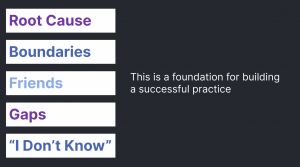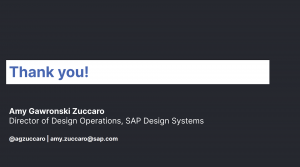DesignOps Summit 2021- Advice for DesignOps Employee #1 (Amy Zuccaro)
Director of Design Operations, SAP Design Systems
I’m here to give you advice as Design Ops employee #1 in your organization
- 70% of DesignOps teams are one person only
- I started at SAP 2 years ago as Design Ops Employee #1
- My goal today is to help you build a strong foundation for your practice in the organization you’re currently in and the next ones you’ll be in, in your future career endeavors
My Story
- I spent 13 years with Semantic, starting off as a Senior Designer and ended up as the Head of Global Consumer Ecommerce UX
- My team sold the Norton products online
- I managed the people and made sure they had what they needed to be successful, optimize the processes, help set the design strategy, and dealt with the workflow – how we interacted with other teams in our organization
- I left Norton to join SAP about 2 years ago, as Head of Design Ops for the New Ventures and Technology group – we were responsible for future proofing SAP
Future Proofing SAP
- One way we did this was through the Venture studio
- We have 4-6 employee led product teams
- Functioned essentially as a startup company within the giant framework of SAP
- They get funding, unique branding, and they’re left a little bit to their own devices on how to run their companies and eventually get on the SAP price list
- We broke out our design team and we ran it like an agency model
- Our essential design team → we would loan designers to these companies to help them get started
- Once they were at a maturity level where they could hire their own designers, those people became part of our extended design team → they were not out there by themselves, they could still be part of the design community
- A Couple months ago I moved to the SAP Design System team, leading the design operations for the team that builds the design systems for all our SAP products
- I’ve learned a few things over the years and even though the teams I’ve worked on were vastly different there’s a few common threads that run through them
- To be successful you must break down your approach to the simplest questions.
Where to start on day 1?
- Do you look at the people and organization and see how things are organized?
- Do you try to tackle the tooling your designers are using?
- Do you set up a research process?
- Do you fix workflow?
It’s overwhelming
My first piece of advice is to start where the biggest problems are
#1 Understand the Root Cause
- Ask yourself what was the catalyst that got your head count approved, why are you here, what made leadership see the value of design operations
- If you understand the root cause of why you were hired, it will make your job a lot easier
- Meet with your team and figure out where or what in their job needed more love and find a solution
#2 Set the boundaries, and respect them
- Establish roles and responsibilities and know who does what. Then stick to it
- Establish the roles and responsibilities early on and if issues arise → be transparent and communicate
#3 Make lots of friends
- Talk to anyone and everyone who will take your call, both inside and outside your organization
- Have one on one meetings with your team – build trust
- When you listen to people, they will tell you all kinds of things
- You need to have friends everywhere in every department → This will help you find out how things get done in your company
#4 Find the gaps and fill them
- If you listen, people will tell you what’s broken, and help you understand how you can fix it
- You’ll only know where the friction in your process is, if you talk to the people who do the work – listen to them and make a list
- The more people that tell you about a particular issue, the higher that prioritizes that issue on the list, then you can start to fix it
#5 Get comfortable with “I don’t know”
- Nobody expects you to know everything, and that’s okay. But they do expect you to learn
- Be sincere when you don’t know the answer, don’t pretend like you do.
-
- Gives you the space you need to find the answer
- It sets the expectation about timing accordingly
- If I don’t know, it’s okay that you don’t know, that way we can solve these problems together
- There is a second part to “I don’t know,” and that’s “I’ll find out”
Recap:



